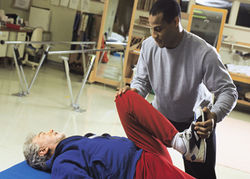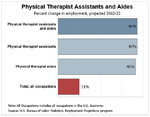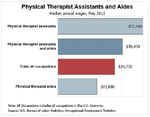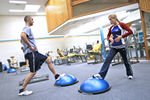Physical therapist assistant
Physical therapist assistants (sometimes called PTAs) and physical therapist aides work under the direction and supervision of physical therapists. They help patients who are recovering from injuries and illnesses regain movement and manage pain.[1]
Physical activity keeps the body in shape and keeps a person healthy. Working-out does not keep people healthy alone, but it does help in a significant way. God tells man that when he accepts Jesus Christ into his heart, his body becomes a temple. A person should keep their body healthy. When one injures himself, often during a physical activity, he must nurse his body back to health. Some injuries result in worse shape than others and require more work to become better. Most of the time, this calls for a physical therapist or a physical therapist assistant.
A physical therapist examines and diagnoses a patient. The physical therapist assistant then goes through the exercises with the patient that is given by the physical therapist. Jobs for physical therapist assistants is expected to grow throughout the years as the need for them become increasingly larger. This job pays considerably well for a single person as it pays about fifty thousand dollars annually. For this career one must take a two year accredited program for a physical therapist assistant. After that, that person must take and pass the licensure exam. Once completing that, one can look for a job. This job as quite flexible hours, depending on the place of work, giving a person the opportunity to go to a four year college and become the actual physical therapist if they desire.
What is a PTA?
Physical therapist assistants, or PTA's, have multiple jobs. They observe their patients before, during, and after therapy. After the therapy session, they take notes and report the patient's status to a physical therapist. During the therapy session, the physical therapist assistants help their patients work on specific exercises. They use multiple different techniques such as a massage or stretching, and also the use of specific devices or equipment. The physical therapist assistants educate their patient and his family members on what to do after treatment. A physical therapist assistant's job is to help patients in muscle movement to develop or regain mobility, to relieve pain, or to lessen or prevent physical disability or immobility.
Remington College states that physical therapist assistants help their patients learn and perform rehabilitative exercises[2]. The assistants perform ultrasounds, electrical hot and cold stimulations, and mechanical traction therapies. Physical therapist assistants must also provide balance, specifically in gait training, and also record their patients' progress. However, a physical therapist assistant has the risk of back injuries because they are on their feet and moving very frequently. Physical therapist assistants set up equipment and help treat patients, lifting and moving them. Assistants can lower the risk of back injury by using proper techniques when assisting patients[3].
Job Market
The aging population and increased birth rate means an expected increased demand for physical therapy services. The older population today has stayed more active later in life than previous generations. Although, heart attacks and strokes have become more common which calls for more cardiac and physical rehabilitation. Older patients show more vulnerability to multiple chronic and debiliating conditions that require therapeutic services, making the roles of physical therapist assistants vital. As chronic diabetes and obesity grows, so does the need for physical therapist assistants to help those patients to maintain their mobility and manage the effects. Therapy and rehabilitative services will rise as the percentage of trauma victims, newborns with birth defects survive, and the number of patients who will recieve access to health insurance all rise [4].
The Bureau of Labor Statistics states that "[p]hysical therapists are expected to increasingly use physical therapist assistants in order to reduce the cost of physical therapy services. Once the physical therapist has evaluated a patient and designed a plan of care the assistant can provide many parts of the treatment, as directed by the therapist"[4]. Opportunities for physical therapist assistants expect to be promising as physical therapists will need them to care for more patients. Better job oppurtunities will arise in places which care more for the elderly, and are treated more in rural areas than in urban or suburban areas. The employment for physical therapist assistants was said to be, by the Bureau of Labor Statistics in 2012, 71,400 people and the projected employment, in 2022, 100,700 people[4]. The downside of this career is that one cannot really move up in his career. One could move up by becoming the actually therapist, however the future of this career pretty much stays the same. However, the dependency of this career is pretty high and will probably stay there for quite some time.
Salary
The Bureau of Labor Statistics states that in May of 2012, the median annual wage for a physical therapist assistant was $52,160. The lowest ten percent earned less than $32,420, and the top ten percent earned more than $72,720 [5]. Southwestern Illinois College states that "[t]he median income for PTAs with one to three years experience is between $37,000 and $42,000 annually, depending on the type and location of the health care facility"[6]. Right now, most families in the working class to lower-middle class can live a lifestyle earning about $30,000 a year if not less. For a person beginning a new life out on their own for awhile, this job promises a comfortable lifestyle.
Department of Labor's Bureau of Labor Statistics stated that in 2012, about 71,400 jobs for physical therapist assistants were available[4]. About forty percent of physical therapist assistants were hired in physical, occupational and speech therapist offices, and audiologist offices. Hospitals hired about twenty-seven percent, whereas nursing care facilities hired eleven percent. Home and health care services hired eight percent of physical therapist assistants and physician offices hired five percent[3]. As a physical therapist assistant, "[m]ost physical therapist assistants and aides work full time. Many physical thereapy offices and clinics have evening and weekend hours to accommodate patients' schedules"[3]. A physical therapist assistant has multiple choices of where he could work. There is physical therapy in hospitals, outpatient clinics, home health environments, nursing homes, schools, sports facilities, fitness centers, and at industrial/occupational settings[6]. The Bureau of Labor Statistics state that the "[e]mployment of physical therapist assistants is projected to grow 41 percent from 2012 to 2022, much faster than the average for all occupations"[4].
Education
The education needed to become a physical therapist assistant is to have an associate's degree from an accredited physical therapist program. This is the requirement in most states. The Bureau of Labor Statistics state that in 2012, about 298 associate's degree programs were offered for this profession[7]. The program required usually lasts about two years meaning five semesters. The course study consists of courses in anatomy, physiology, english, algebra, and psychology. The course study also includes clinical and hand-on experiences in treatment centers. Students also have the chance to earn cardiopulmonary resuscitation, or CPR, certifications.
The Bureau of Labor Statistics state that physical therapist aids do not require a license, whereas physical therapist assistants have to either have a license or certificate in all states except for Hawaii. A student must graduate from an accredited physical therapist assistant program and pass the National Physical Therapy Exam in order to receive a license. A few states require additional state exams, a criminal record check, and the age limit of eighteen. A person must check with their state board for licensing requirements. Some assistants may have to continue courses in order to keep their license. This job involves interacting with patients and caring for them. As education is needed for this career, one should have certain qualities if he has the desire to pursue physical therapy. Some of those qualities should include compassion, dexterity, interpersonal skills, and physical stamina. He should also enjoy physical activity and like organization and detail[7].
Video
Here is a video explaining what a physical therapist assistant is and what they do.
References
- ↑ Physical Therapist Assistants and Aides U.S. Bureau of Labor Statistics Web. Publish January 8, 2014
- ↑ What tasks are typically performed in Physical Therapist Assistant jobs? Remington College. Web. 5 May 2015 (Accessed).
- ↑ 3.0 3.1 3.2 Work Environment Bureau of Labor Statistics. Web. 8 January 2014 (Published).
- ↑ 4.0 4.1 4.2 4.3 4.4 Job Outlook Bureau of Labor Statistics. Web. 8 January 2014 (Published).
- ↑ Pay Bureau of Labor Statistics. Web. 8 January 2014 (Published).
- ↑ 6.0 6.1 Physical Therapist Assistant Southwestern Illinois College. Web. 18 May 2015 (Accessed).
- ↑ 7.0 7.1 How to Become a Physical Therapist Assistant or Aide Bureau of Labor Statistics. Web. 8 January 2014 (Published).
| ||||||||||||||||||||




